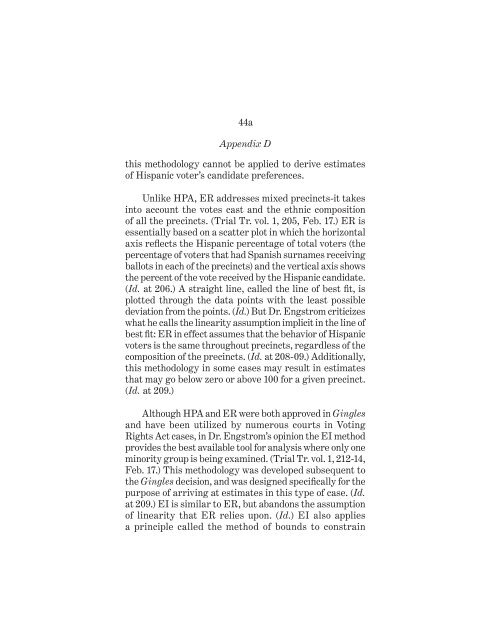petitioned the U.S. Supreme Court to grant ... - Election Law Blog
petitioned the U.S. Supreme Court to grant ... - Election Law Blog
petitioned the U.S. Supreme Court to grant ... - Election Law Blog
You also want an ePaper? Increase the reach of your titles
YUMPU automatically turns print PDFs into web optimized ePapers that Google loves.
44aAppendix Dthis methodology cannot be applied <strong>to</strong> derive estimatesof Hispanic voter’s candidate preferences.Unlike HPA, ER addresses mixed precincts-it takesin<strong>to</strong> account <strong>the</strong> votes cast and <strong>the</strong> ethnic compositionof all <strong>the</strong> precincts. (Trial Tr. vol. 1, 205, Feb. 17.) ER isessentially based on a scatter plot in which <strong>the</strong> horizontalaxis reflects <strong>the</strong> Hispanic percentage of <strong>to</strong>tal voters (<strong>the</strong>percentage of voters that had Spanish surnames receivingballots in each of <strong>the</strong> precincts) and <strong>the</strong> vertical axis shows<strong>the</strong> percent of <strong>the</strong> vote received by <strong>the</strong> Hispanic candidate.(Id. at 206.) A straight line, called <strong>the</strong> line of best fit, isplotted through <strong>the</strong> data points with <strong>the</strong> least possibledeviation from <strong>the</strong> points. (Id.) But Dr. Engstrom criticizeswhat he calls <strong>the</strong> linearity assumption implicit in <strong>the</strong> line ofbest fit: ER in effect assumes that <strong>the</strong> behavior of Hispanicvoters is <strong>the</strong> same throughout precincts, regardless of <strong>the</strong>composition of <strong>the</strong> precincts. (Id. at 208-09.) Additionally,this methodology in some cases may result in estimatesthat may go below zero or above 100 for a given precinct.(Id. at 209.)Although HPA and ER were both approved in Ginglesand have been utilized by numerous courts in VotingRights Act cases, in Dr. Engstrom’s opinion <strong>the</strong> EI methodprovides <strong>the</strong> best available <strong>to</strong>ol for analysis where only oneminority group is being examined. (Trial Tr. vol. 1, 212-14,Feb. 17.) This methodology was developed subsequent <strong>to</strong><strong>the</strong> Gingles decision, and was designed specifically for <strong>the</strong>purpose of arriving at estimates in this type of case. (Id.at 209.) EI is similar <strong>to</strong> ER, but abandons <strong>the</strong> assumptionof linearity that ER relies upon. (Id.) EI also appliesa principle called <strong>the</strong> method of bounds <strong>to</strong> constrain








